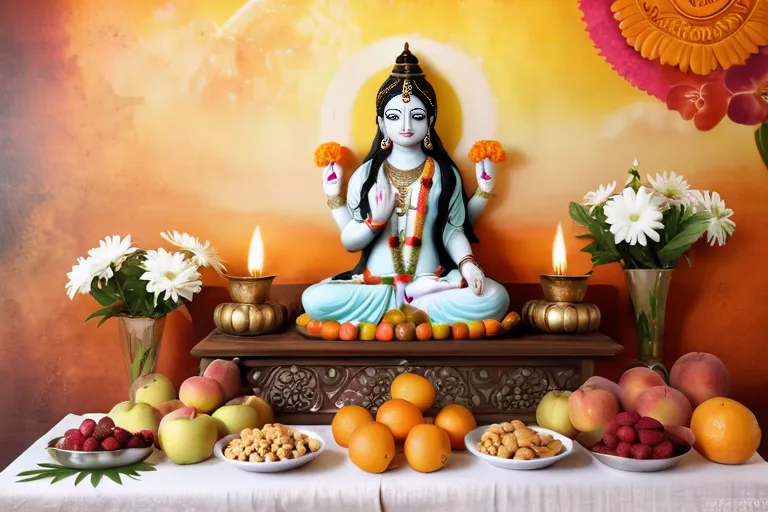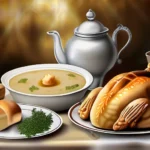Explore the cultural, religious, and philosophical aspects behind this ancient practice
Discover the rich tradition of offering food to Hindu gods and learn about its historical roots, symbolic meanings, and spiritual significance.
The Historical Origins of Food Offerings
The historical origins of food offerings in Hinduism can be traced back to Vedic times, where the practice was deeply intertwined with daily life and spiritual devotion. Imagine a time when every meal wasn’t just about nourishment but also about invoking divine blessings—wouldn’t that transform your perspective on eating? These ancient rituals were not merely symbolic gestures; they played a crucial role in maintaining cosmic balance and harmony.
Consider the act of offering food to deities as a bridge between the mundane and the sacred. Just like how building a sturdy foundation is essential for any structure, these offerings laid the groundwork for spiritual sustenance. In the Rig Veda, we find references to food offerings, known as yajnas, which were performed by priests to please deities and ensure prosperity.
Think of it this way: in a world where everything had its place and purpose, even the simplest act like offering food held profound significance. These rituals weren’t just about pleasing gods; they were also about fostering a sense of community and shared responsibility. By engaging in these practices, people acknowledged their interdependence with the divine and each other.
The evolution from simple offerings to more complex rituals is fascinating. Over time, various deities came to be associated with specific types of food, creating a rich tapestry of symbolism. For instance, Saraswati might receive offerings of books or musical instruments, reflecting her domains over knowledge and arts.
Incorporating these practices into one’s daily life wasn’t just about following tradition; it was about living in harmony with the divine order. By offering food to deities, individuals sought blessings not only for themselves but also for their families and communities. This practice underscored the belief that every action had spiritual consequences.
Reflecting on these historical roots helps us understand why food offerings remain an integral part of Hinduism today. From the grandeur of temple rituals to the simplicity of home altars, this tradition continues to weave through the fabric of daily life, reminding us of our interconnectedness with the divine and each other.
Wouldn’t it be interesting to explore how these ancient practices have shaped modern religious observances? The journey from Vedic times to contemporary rituals is a testament to the enduring power of these traditions in shaping spiritual beliefs and practices.
Symbolic Meanings Behind Food Offerings
Imagine a grand feast, where each dish holds more than just nourishment; it carries centuries-old symbolism and profound spiritual significance. In Hinduism, food offerings to deities are not merely symbolic acts but are deeply embedded in cultural, religious, and philosophical practices that have evolved over millennia.
Think of these offerings as a bridge between the earthly realm and the divine. What does one offer when seeking blessings? A humble plate of rice or a fragrant array of fruits? Each choice carries its own meaning. For instance, rice, often symbolizing wealth and prosperity, is frequently offered to appease deities like Ganesha, who is known as the remover of obstacles.
Fruits, too, are significant, with each type representing different virtues or desires. Consider the banana, a symbol of fertility and growth, often offered to goddesses associated with motherhood. Meanwhile, coconut is revered for its ability to purify the mind and body, making it an essential offering in many rituals.
The variety of offerings also reflects the diversity of Hindu beliefs and practices. Devotees might offer sweets, representing love and devotion (think of Laxmi, the goddess of wealth), or even flowers, which symbolize purity and are often dedicated to Saraswati, the deity of knowledge.
In a way, these offerings are not just about giving; they are acts of receiving. By placing food before deities, believers seek blessings for themselves and their loved ones, hoping that the divine grace will permeate every aspect of life—health, prosperity, wisdom, and happiness.
So, next time you see a plate of offerings laid out in a temple, remember that it is more than just an act of worship. It’s a rich tapestry woven with threads of tradition, culture, and spirituality, reminding us of our interconnectedness with the divine.
The Role of Food Offerings in Hindu Philosophy
The role of food offerings in Hindu philosophy is akin to nurturing a sacred bond between humans and deities, a relationship that mirrors the delicate balance in nature. Have you ever wondered why devotees offer prasadam, or holy food, to gods? This practice isn’t just about sharing sustenance; it’s a profound act of devotion steeped in philosophical significance.
In Hindu philosophy, food is more than mere nourishment—it’s a medium through which the divine energy (or bhakti) flows. By offering food to deities, believers are believed to purify both their bodies and souls. This act of offering symbolizes the belief that food is not just physical but has a spiritual essence that can be shared.
Consider the metaphorical garden of life where prasadam serves as the soil in which the seeds of faith are sown. Just as plants require sunlight, water, and nutrients to thrive, devotees believe that by offering food, they nurture the divine presence within themselves. This practice is not just an act of worship but a way to understand the interconnectedness of all life.
The Philosophy of Bhakti Yoga emphasizes love and devotion as paths to spiritual growth. By engaging in these rituals, devotees are practicing bhakti, or devotional service, which is said to bring them closer to the divine. The offering of food becomes a form of service that transcends mere activeness—it’s a way to express gratitude and love.
Moreover, this practice reflects the ancient belief in the power of sacred vibrations. When food is offered with pure intentions and devotion, it is said to resonate at a higher frequency, bringing about positive changes not only within the individual but also in the surrounding environment. It’s as if each offering is a prayer that amplifies the divine energy around us.
So next time you witness or participate in an offering ceremony, think of it as more than just an act of worship; it’s a momentous ritual that embodies deep philosophical and spiritual principles. By understanding this practice, we gain insight into how ancient wisdom continues to influence our lives today, fostering a deeper connection between the earthly and the divine.
The Preparation and Rituals Surrounding Food Offerings
The preparation and rituals surrounding food offerings to Hindu deities are intricate and profound, like weaving threads into a rich tapestry. Have you ever wondered why certain ingredients are chosen for these sacred meals? The selection of grains, fruits, vegetables, and pulses is not just about nourishment; it’s about invoking the divine essence within each item. Imagine walking through a vibrant market, where vendors carefully measure and select items that will be blessed before they make their way to the altar.
Each ingredient has its significance. For instance, rice symbolizes purity and abundance, while coconut is seen as a symbol of fertility and prosperity. These choices are not random; they reflect the belief that every element contains within it a divine spark, waiting to be invoked through ritual. The process itself becomes a prayer, a dance between human effort and divine grace.
The presentation of offerings is equally important. Arranging the food on a ceremonial plate or thali with meticulous care turns the act into a work of art. Each item placed with intention, creating an altar that serves as a bridge between the physical world and the spiritual realm. It’s like setting up a grand feast for honored guests, where every dish is prepared with utmost respect and devotion.
These rituals also serve to connect worshippers directly with their deities. By partaking in these offerings, devotees feel closer to the divine, as if they are sharing a meal with their gods. It’s a shared experience that transcends time and space, making the sacred tangible through each bite of blessed food. These acts of devotion are not just about pleasing the deity but also about reaffirming one’s commitment to ethical living.
In this way, the preparation and rituals surrounding food offerings become more than just a ceremony; they embody the very essence of Hindu philosophy—harmony, respect, and devotion. By engaging in these practices, one can experience a deeper connection with the divine, making each offering a step closer to spiritual enlightenment.
The Importance of Food Offerings in Modern Hinduism
As we delve into the importance of food offerings in modern Hinduism, one can’t help but wonder about the enduring relevance of this ancient practice. Isn’t it fascinating how a simple act like offering food can hold such profound spiritual significance?
The continued relevance of food offerings lies not just in their ritualistic value but also in their role in preserving cultural traditions. In today’s fast-paced world, where technology and modernity often overshadow traditional practices, these offerings serve as a vital link to our heritage.
Consider the symbolic nature of food in Hinduism; it is seen as an embodiment of life and sustenance. When devotees offer food to deities, they are essentially partaking in a divine act of nurturing and gratitude. This act of sharing reflects the belief that the divine requires nourishment just as humans do, creating a seamless connection between the earthly and the divine.
Moreover, these offerings are not merely symbolic; they play a crucial role in maintaining the community bond within Hindu society. The process of preparing and distributing food fosters a sense of togetherness and shared responsibility. It’s akin to a communal meal where everyone participates—albeit in a sacred space.
The impact of these offerings on the broader culture is evident too. They shape dietary habits, culinary practices, and social interactions. From the humble household shrine to grand temple festivals, food offerings are central to religious observance, making them an integral part of daily life for many Hindus.
Thus, in a world that often seeks to compartmentalize religion from everyday life, food offerings serve as a bridge, keeping spiritual practices alive and vibrant. They remind us that our actions are imbued with meaning and purpose, connecting the personal with the divine through simple acts of offering.
The continued relevance of these offerings is not just about maintaining tradition but also about finding new ways to express devotion in an evolving society. As modern Hindus navigate their spiritual journeys, food offerings remain a timeless and powerful means to seek blessings and find inner peace.
The Impact of Food Offerings on Hindu Art and Architecture
The impact of food offerings on Hindu art and architecture cannot be overstated. Just imagine, for centuries, these offerings have not only nourished the deities but also provided a rich tapestry that shapes the very essence of Hindu worship spaces. These vibrant offerings—from fresh fruits to elaborate dishes—find their reflection in the intricate carvings and sculptures adorning ancient temples.
Consider the intricate carvings on the walls of a temple; each one tells a story, often depicting scenes from Hindu epics where deities are shown accepting offerings. These depictions serve as a visual reminder of the significance of food in religious rituals. The sculptures, with their detailed craftsmanship, highlight the divine connection through symbolism and metaphor, making every visit to a temple a visual feast that educates as it worships.
In temples, one can also witness the influence of food offerings on architecture itself. The grandeur of the sanctum sanctorum often reflects the scale and variety of offerings it could accommodate. The design not only facilitates the placement of these offerings but also creates an atmosphere of devotion and reverence. Think about how a single offering niche, strategically placed, can transform into a symbol of divine acceptance and grace.
The paintings in temple walls further illustrate this connection. They depict mythological stories with deities accepting offerings from devotees, thus blending historical narratives with religious symbolism. Each stroke of the brush captures not just a moment but a tradition that has been upheld for centuries through food offerings.
Conclusion
 Gain a deeper understanding of the importance of food offerings in Hinduism and appreciate their role in maintaining harmony between humans and deities.
Gain a deeper understanding of the importance of food offerings in Hinduism and appreciate their role in maintaining harmony between humans and deities.











